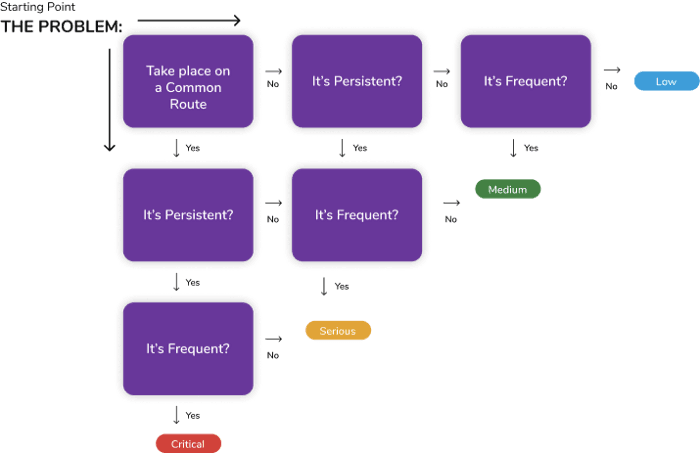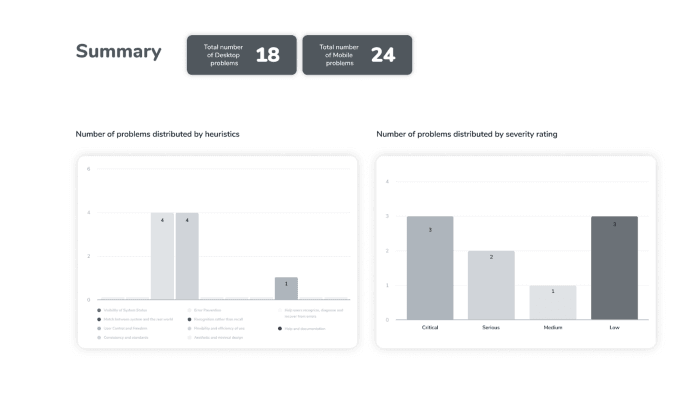You already know the sections of a UX Review and why each one is important, but how to do it? To establish the usability problems and strengths you will need to have a set of guidelines and heuristics to start on. There are many of them out there, but is safe to assume that the most commonly used is the 10 Usability Heuristics by Jakob Nielsen.
Others can be:
- Weinschenk and Barker's classification
- ISO Dialogue Principles
- Shneiderman’s Eight Golden Rules
- 247 web usability guidelines
- Guidelines by Smith & Mosier (this one contains almost 1.000 guidelines!)
You can also combine heuristics to customize your own set that is most applicable to your platform in analysis or for your company.
Now, to establish the severity rating of the problems you will need to have a way to identify the factors and their extension.
As has been written here, there are 3 variables (Impact, Persistence, Frequency) that help to identify the heaviness of a problem.
Impact
You need to know if the problem occurs in a section of the application that is more commonly used.
How?
You need to establish a method or tool that helps you understand what the user does in the app and classify those tasks as more or less common. This will help to understand if the problem occurs in an area that is commonly used. First, you need to know the goals and the tasks of your users and the most habitual ones.
Summarizing it, the more common a task is the more the user will use that area(s) of the application in order to achieve his goals. If the problem occurs in those areas the problem has a high impact.
Useful tools/ methods:
- Red Routes
- Surveys
- Tasks analysis
Persistence
You need to know if the problem is difficult to overcome.
How?
You need to establish a method or tool that helps you understand if the user can finish those tasks and achieve the goal. And if he can do it how they do it. How many times is successful in doing it is also excellent data to have.
Summarizing it, the more difficult a task is to complete the more persistent is the problem.
Useful tools/ methods:
- Complete a task yourself (as a tech-savvy you can assume if it is difficult for you, it must be for more less experienced users)
- Access to completion rate data (if possible)
Frequency
You need to know if the problem happens a lot or not.
How?
You need to establish a method or tool that helps you understand how many times it happens and how many places it happens.
Summarizing it, the more times a problem appears the more frequent is the problem.
Useful tools/ methods:
Explore the problem yourself (countdown how many times you identify the problem cross by the application, the times it appears will reflect the frequency of it. If it happens ⅛ of the time is not that frequent) After all of this is identified it’s time to break it down to the actual level:

Interpret the severity rating
Critical
This usability problem may make some users unwilling or unable to complete a common task. Fix urgently.
Serious
This usability problem may significantly slow down some users when completing a common task and may cause customers to find a workaround. Fix it as soon as possible.
Medium
This usability problem may make some users feel frustrated or irritated but will not affect task completion.
Low
This is a problem that regards a quality, for example, a cosmetic issue or a spelling error.
Note: Although this is a minor issue in isolation, too many “lows” will negatively affect credibility and may damage your product.

Ask for a second and a third input
A single reviewer only covers 60% of the usability problems. You will need from 2 to 5 reviewers. The reasons are:
- Some reviewers have more domain knowledge than others in some business areas (depending on the business of the app) which means they can find problems you’ll miss
- Some reviewers tend to be sensitive or more skilled to a sub-set of usability issues (some on visual design, others with information architecture
- Some reviewers had more experience gained with exposure to users (with usability tests or field visits) and this means they are more sensitive to identifying the usability issues that may affect people in the real world
Ideally, the reviewers should be experts in usability and the subject domain of the project.
When a UX Expert Review should be done?
- Can be done for desktop, tablet or mobile applications
- Can be executed at any phase in the design cycle
- Typically is used before a major redesign project
- Ideally is conducted every 2 to 5 years
- Applications that have never been submitted to a design review
- Applications that have to validate new designs
As you can see, this is a version of a major report that involves significant work, and the evidence of it relies initially on the client's engagement in gathering all the data to start the analysis. It’s a great method because allows having in one place an extensive analysis and justifications for everything.
This is part II of an article, click here if you want to see part I. Cover photo by Jason Goodman on Unsplash